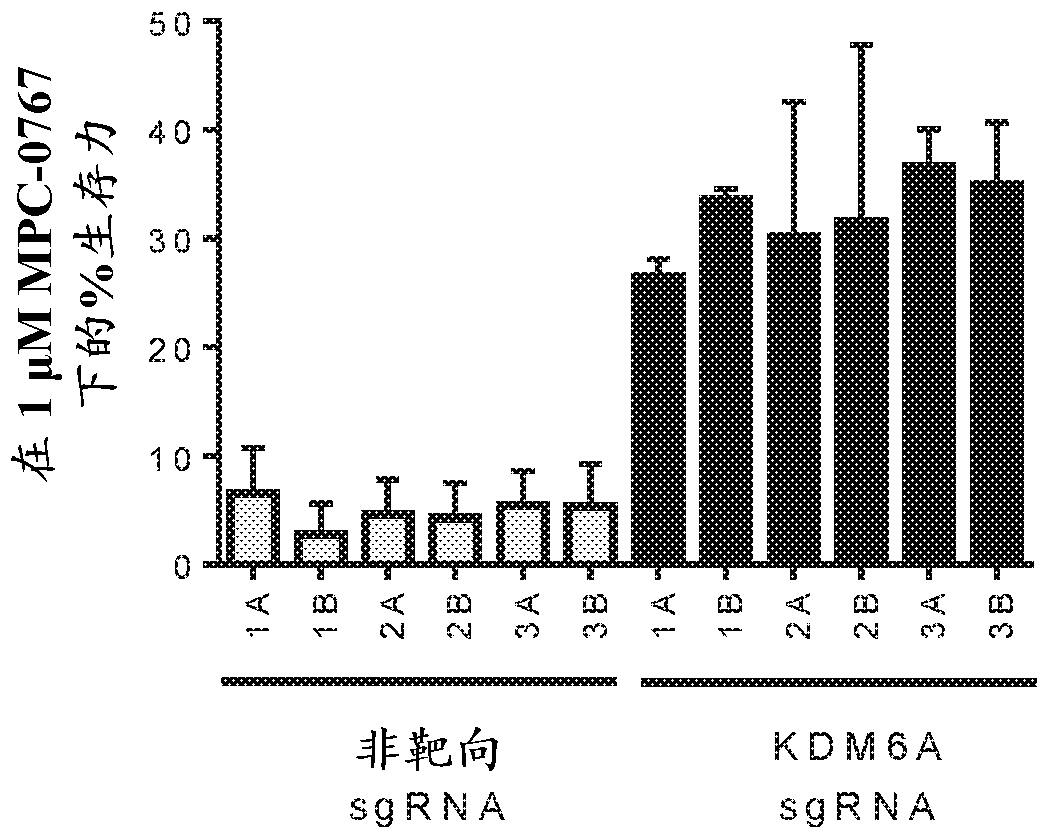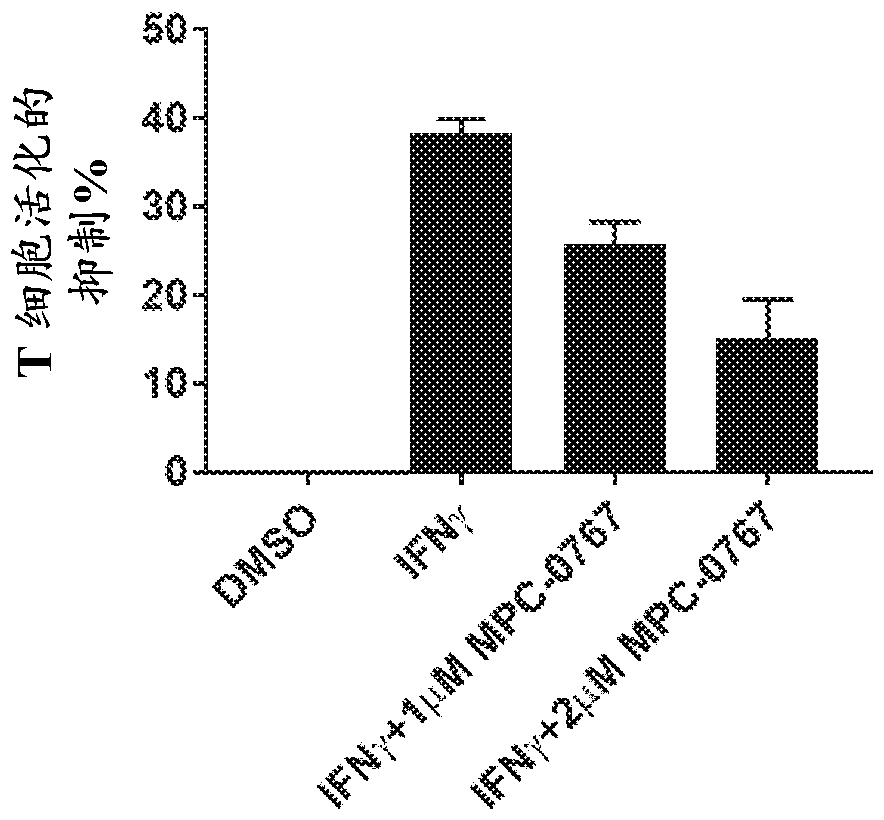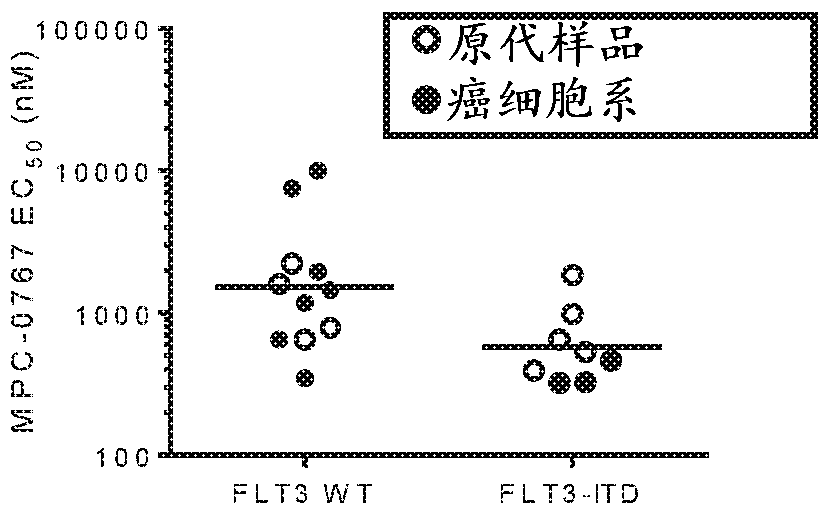Therapeutic methods relating to hsp90 inhbitors
一种抑制剂、治疗剂的技术,应用在HSP90抑制剂领域,能够解决没有HSP90抑制剂测试、未获准用于人类等问题
- Summary
- Abstract
- Description
- Claims
- Application Information
AI Technical Summary
Problems solved by technology
Method used
Image
Examples
Embodiment 1
[0235] Example 1: MPC-0767 Inhibits Cell Viability of NSCLC Cell Lines Carrying EGFR and HER2 Mutations
[0236] NSCLC cell lines HCC-827 (EGFR L858R), H1975 (EGFR L858R / T790M) PC-9 (EGFR DelE746_A750) and H1781 (HER2 G7776insV G / C) were treated with MPC-0767 at concentrations ranging from 98 - 50000 nM3 days, use CellTiter-Glo after this time ® Reagents to determine cell viability. Figure 1 shows HCC-827 ( Figure 1A ), H1975 ( Figure 1B ), PC-9 ( Figure 1C ) and H1781 ( Figure 1D ) dose-response curve of the cell line. All ECs 50 The values are all within the clinically achievable concentration range.
[0237] To verify the mechanism of cell viability loss, H1975 cells were treated with MPC-0767 (0.7 µM) for 72 hours. After this time, cells were stained with 7-aminoactinomycin D (7-AAD) and annexin V (markers of cell membrane integrity and apoptosis), respectively. like figure 2 As shown, treatment of H1975 cells with MPC-0767 (0.7 µM) resulted in a decrease i...
Embodiment 2
[0242] Example 2: MPC-0767 exhibits potent anti-leukemic activity in AML cells with FLT3-ITD
[0243] Exponentially growing cell lines were counted and seeded into 96-well clear flat-bottom polystyrene microtiter plates at a final volume of 90 µL per well. For primary AML samples, cells were split in 2 x 10 4 Cells were seeded into 384-well plates in a final volume of 27 µL per well. For treatment of cell lines or primary samples, 10 µL or 3 µL of 10X concentration of MPC-0767 is then added to the cells to make final concentrations of 10000 nM, 5000 nM, 2500 nM, 1250 nM, 625 nM, 313 nM, respectively , 156 nM, 78 nM, 39 and 20 nM. For comparison, cells were treated with the FLT3 inhibitor gitertinib (100 nM, 50 nM, 25 nM, 12.5 nM, 6.3 nM, 3.1 nM, 1.6 nM, 0.8 nM, 0.4 and 0.2 nM). Cells were seeded and processed in duplicate. After 3 days of incubation, cell viability was determined by adding 100 µL per well of a 96-well plate or 30 µL per well of a 384-well plate by measurin...
Embodiment 3
[0246] Example 3: MPC-0767 is cytotoxic in primary AML cells with FLT3-ITD
[0247] To test whether the anti-leukemic effect of MPC-0767 was due to induction of cell death, 4 primary AML samples (all with FLT3-ITD) were treated with increasing concentrations of MPC-0767 for 72 hours. Samples were then processed to quantify cells positive for Annexin V and 7AAD by flow cytometry. These markers allow detection of cell death, specifically, death (positive for 7-AAD only), early apoptosis (positive for Annexin V only), or late apoptosis / necrosis (positive for 7-ADD and Annexin V) ) population combination to give a cell death readout.
[0248] Such as Figure 6 As shown, primary AML samples treated with MPC-0767 showed a dose-dependent increase in cell death. Notably, one of the samples (Y1265) was obtained from a patient who relapsed on gitertinib.
[0249] These findings suggest that MPC-0767 induces cell death in primary AML samples with FLT3-ITD by inducing apoptosis. In a...
PUM
 Login to View More
Login to View More Abstract
Description
Claims
Application Information
 Login to View More
Login to View More - R&D
- Intellectual Property
- Life Sciences
- Materials
- Tech Scout
- Unparalleled Data Quality
- Higher Quality Content
- 60% Fewer Hallucinations
Browse by: Latest US Patents, China's latest patents, Technical Efficacy Thesaurus, Application Domain, Technology Topic, Popular Technical Reports.
© 2025 PatSnap. All rights reserved.Legal|Privacy policy|Modern Slavery Act Transparency Statement|Sitemap|About US| Contact US: help@patsnap.com



